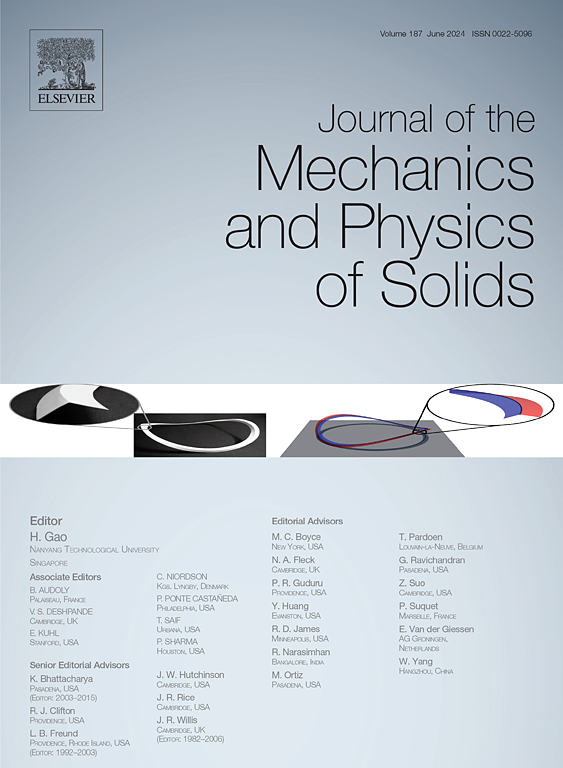具有表面张力的密闭生物囊泡的熵压
IF 6
2区 工程技术
Q2 MATERIALS SCIENCE, MULTIDISCIPLINARY
引用次数: 0
摘要
熵力在软物质系统的动力学和稳定性中起着至关重要的作用,特别是在生物膜和囊泡中。这些力的来源在于软膜的显著热波动,这是科学界几十年来一直感兴趣的课题。大多数研究都集中在问题的简化版本上:一个平坦的,无张力的膜,而不是更复杂的具有预先存在的曲率和表面张力的非平面表面。在本文中,我们利用统计力学分析和粗粒度分子动力学模拟,明确地结合了它们的曲率场和表面张力,重新审视了这个问题。变形场和非零曲率场之间的耦合导致了重归一化的表面张力,与平面膜相比,显著改变了熵力。我们证明,虽然熵压p在小距离处遵循与平面膜相似的幂律行为,p∝1/d3,但在较大距离处它转变为指数衰减。这些发现提供了对表面张力、膜结构和热波动的耦合效应的见解,特别是对于理解生物过程,如囊泡融合、内吞作用和拥挤细胞环境中膜介导的相互作用。本文章由计算机程序翻译,如有差异,请以英文原文为准。
Entropic pressure on a confined biological vesicle with surface tension
Entropic forces play a critical role in the dynamics and stability of soft matter systems, particularly in biological membranes and vesicles. The origin of these forces lies in the significant thermal fluctuations of soft membranes, a subject that has intrigued the scientific community for decades. Most studies focus on a simplified version of the problem: a flat, tensionless membrane, rather than more complex non-planar surfaces with pre-existing curvature and surface tension. In this paper, we revisit this problem for confined biological vesicles using statistical mechanics analysis and coarse-grained molecular dynamics simulations, explicitly incorporating their curvature field and surface tension. The coupling between the deformation field and the non-zero curvature field leads to a renormalized surface tension, significantly altering the entropic force compared to that of a planar membrane. We demonstrate that while the entropic pressure follows a similar power-law behavior to that of a planar membrane at small distances, , it transitions to an exponential decay at larger distances. These findings provide insights into the coupled effects of surface tension, membrane configuration, and thermal fluctuations, particularly for understanding biological processes, such as vesicle fusion, endocytosis, and membrane-mediated interactions in crowded cellular environments.
求助全文
通过发布文献求助,成功后即可免费获取论文全文。
去求助
来源期刊
CiteScore
9.80
自引率
9.40%
发文量
276
审稿时长
52 days
期刊介绍:
The aim of Journal of The Mechanics and Physics of Solids is to publish research of the highest quality and of lasting significance on the mechanics of solids. The scope is broad, from fundamental concepts in mechanics to the analysis of novel phenomena and applications. Solids are interpreted broadly to include both hard and soft materials as well as natural and synthetic structures. The approach can be theoretical, experimental or computational.This research activity sits within engineering science and the allied areas of applied mathematics, materials science, bio-mechanics, applied physics, and geophysics.
The Journal was founded in 1952 by Rodney Hill, who was its Editor-in-Chief until 1968. The topics of interest to the Journal evolve with developments in the subject but its basic ethos remains the same: to publish research of the highest quality relating to the mechanics of solids. Thus, emphasis is placed on the development of fundamental concepts of mechanics and novel applications of these concepts based on theoretical, experimental or computational approaches, drawing upon the various branches of engineering science and the allied areas within applied mathematics, materials science, structural engineering, applied physics, and geophysics.
The main purpose of the Journal is to foster scientific understanding of the processes of deformation and mechanical failure of all solid materials, both technological and natural, and the connections between these processes and their underlying physical mechanisms. In this sense, the content of the Journal should reflect the current state of the discipline in analysis, experimental observation, and numerical simulation. In the interest of achieving this goal, authors are encouraged to consider the significance of their contributions for the field of mechanics and the implications of their results, in addition to describing the details of their work.

 求助内容:
求助内容: 应助结果提醒方式:
应助结果提醒方式:


